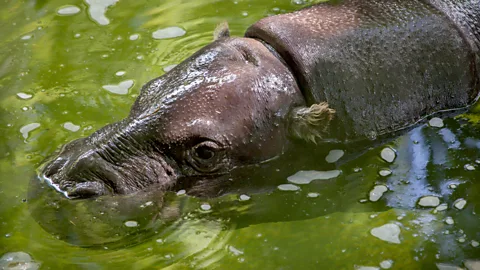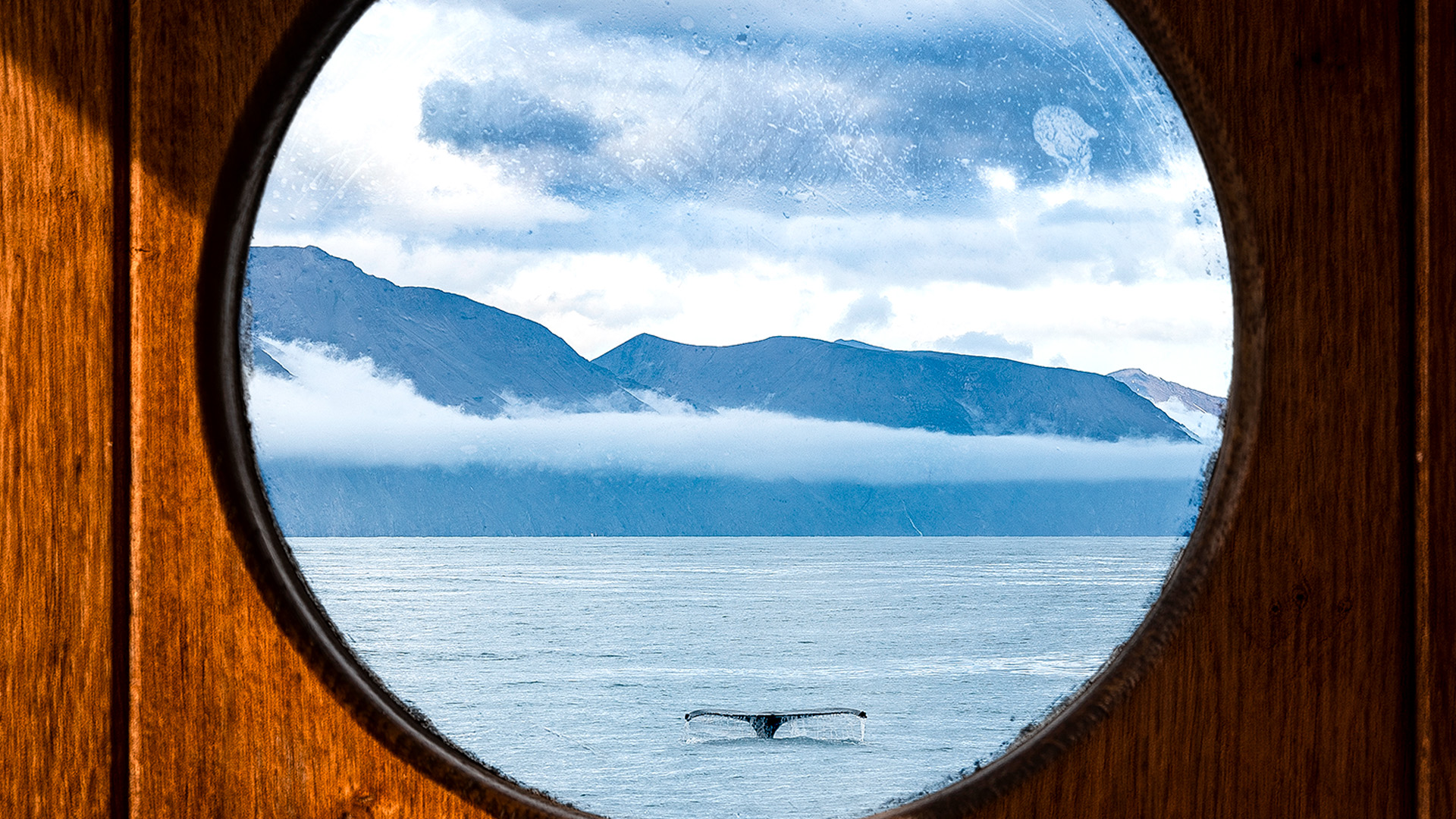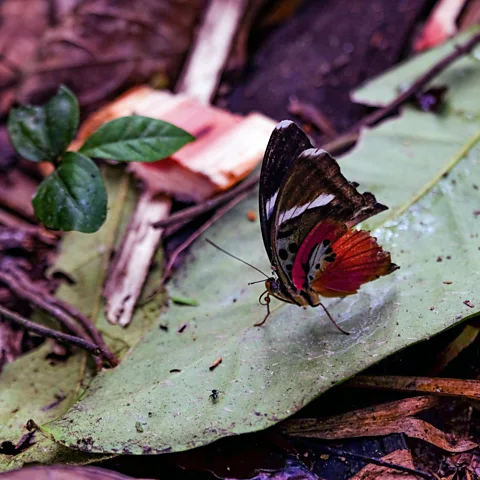The remote isle where pygmy hippos roam
 Ali Lucas-Chee
Ali Lucas-CheeTiwai, meaning "Big Island" in the Mende language, is just 11.9 sq km, yet it shelters pygmy hippos, endangered chimpanzees and some of the world’s densest primate populations. Its recent Unesco recognition marks an exciting new chapter for Sierra Leone.
The journey to Sierra Leone’s first Unesco World Heritage Site is an intrepid one. From the capital, Freetown, travellers trace 240km of tarmac highway before bumping along hours of rust-red, potholed roads to the banks of the Moa River. From there, a dugout canoe ferries them to Tiwai Island and the Gola Rainforest National Park, which is part of the new Unesco inscription. These crossings often take place by torchlight, in the pitch-dark of night.
Visitors are rewarded for their efforts, though. Ensconced in a clearing, among liana vines, javelin-like lengths of bamboo and 12m-tall piptadeniastrum trees, lies a remote wilderness camp where visitors can stay overnight, off-grid.
The camp is an uncomplicated place: a handful of mesh-sided wooden huts containing mosquito net-veiled beds, a bandstand-style communal area for eating and a rustic shower block. Yet people do not come here for home comforts. They visit to stay in an otherwise impenetrable part of the ancient West African rainforest where they can experience the symphonic soundtrack of the jungle at night.
"I remember lying in bed and listening to the cacophony of sounds going off around me," said Bea Meitiner, who spent two nights on the island in 2022. "One night, I woke to the sound of something moving right outside my tent. I froze, my heart was racing, I imagined I was about to be eaten by some predator. The next morning, we spotted the footprints of a pygmy hippo right next to camp. To think such a secretive, rare animal had wandered past while I lay there. It was both terrifying in the moment and magical in hindsight."
 Alamy
AlamyPygmy hippos are just one of the treasures on this "Big Island", which is actually just 11.9 sq km in size. The island also hosts one of the world's largest concentrations of primates. Under its thickly knitted canopy live ginger-whiskered red colobus, Diana monkeys, sooty mangabeys and critically endangered Western chimpanzees.
"We suspect from our camera trapping that there might be three different groups of Western chimpanzees on the island," said Dr Ibrahim Bakarr, who has been conducting primate research here since 2005. "There is one group we think might have about nine individuals."

Ends of the Earth
Sometimes the journey is the adventure. In Ends of the Earth, we revel in far-flung destinations that are well worth the trek.
It is this biodiversity that helped earn Tiwai and Gola their Unesco status in July 2025. The inscription notes that "the area hosts more than 1,000 plant species (113 endemic), 55 mammals (19 globally threatened) and key species like the African Forest Elephant and Pygmy Hippopotamus" along with freshwater fish, butterflies and dragonflies.
Visitors can immerse themselves in this abundance on guided forest walks, night hikes and canoe trips. "My guide was called Bobo, who, when not guiding, is a local farmer, growing cashews and peanuts," said Meitiner. "We did two walks a day. We saw quite a few black and white colobus monkeys and Diana monkeys. The walks were about so much more than wildlife, though. He talked about the plants, showing me which trees were medicinal and which were hallucinogenic. He also talked about the civil war and how it impacted him and his family."
Ali Lucas-Chee, who visited Tiwai as part of a six-month overland trip around Africa with her husband in 2024, took a guided night hike during her stay.
 Sarah Holt
Sarah Holt"We heard hornbills landing, which sounded like miniature helicopters," Lucas-Chee said. "We also heard this really funny sound. I asked my guide if it had started to rain, and he said no, it was the sound of monkeys peeing from the trees nearby."
Tiwai has not always been so full of life. Recognised for its ecological value in the late 1970s, attracting researchers and primatologists from around the world, then designated as a wildlife sanctuary in 1987, the island was devastated during Sierra Leone’s civil war (1991-2002).
Plan your trip:
• The best time to visit is the dry season (November-April).
• Book day trips, overnight stays and canoe crossings at tiwaiisland.org.
• Visitors can also book beds in the research lodge if they are available.
• Guides are mandatory for exploring the forest; book through the website or once you get to camp.
"When I got to Tiwai in 2000, I expected that we would see monkeys all over the place, but it was silent," said Tommy Garnett, founder of the Environmental Foundation (EFA) for Africa, the NGO that played an instrumental role in rehabilitating Tiwai after the conflict and continues to run its eco-tourism facilities. "As far as we could walk, there were empty cartridge shells on the forest floor. Some of the massive trees had been felled. This place was in distress. We realised that this wasn’t something we could walk away from. We had to send out an SOS."
Following his initial visit, Garnett met with local chiefs to discuss a restoration plan.
After a private meeting – known as "hanging heads" – the chiefs agreed to prevent poaching, stop tree felling on Tiwai and allow research facilities from the '80s and '90s to be rebuilt. Yet the work was repeatedly derailed: first by the Ebola outbreak in 2014, followed by a fierce storm in 2015 that damaged 70% of the island’s properties and finally the Covid-19 pandemic.
 Ali Lucas-Chee
Ali Lucas-CheeDespite the setbacks, the EFA, Sierra Leone’s Ministry of Tourism and Unesco experts persevered. In January 2022, the Gola-Tiwai complex made the tentative list, and in July 2025, it was fully inscribed.
"It’s embarrassing for an African man to say I cried, but I did," Garnett said. "I felt vindicated as well as grateful to both Mother Nature and all the people who contributed, right back to the 1970s."
Sierra Leone’s Minister of Tourism, Mrs Nabeela Farida Tunis, also shed a tear when the Unesco inclusion was announced.
"From an emotional standpoint, it was a lot of joy, immense pride and gratitude to everyone who took part in the process," she said. "It was a moment of national celebration. My heart swelled."
More like this:
• The West African nation welcoming the world
• Camping on the world's largest island of ice
• The last places on Earth to see truly dark starry nights
Tiwai’s new Unesco status is part of Sierra Leone's wider sustainability push, with 2025 declared The Year of Eco Tourism and plans for a string of new eco-lodges at destinations like Jaibui Island, south-west of Tiwai.
"Our long-term goal is to position Sierra Leone as a destination for eco-tourism and heritage tourism," Tunis said. "The inscription contributes directly to this vision."
 Ali Lucas-Chee
Ali Lucas-CheeReaching Tiwai may be intrepid, but the island’s journey to Unesco status has been far more challenging. Fortunately, the road ahead looks more like Sierra Leone’s smooth highways than its rust-red, off-road tracks.
"The future is bright," Garnett said. "We’re part of a global family now, and the local chiefs feel a sense of pride that they are owning a Unesco World Heritage site."
--
If you liked this story, sign up for The Essential List newsletter – a handpicked selection of features, videos and can't-miss news, delivered to your inbox twice a week.
For more Travel stories from the BBC, follow us on Facebook and Instagram.
